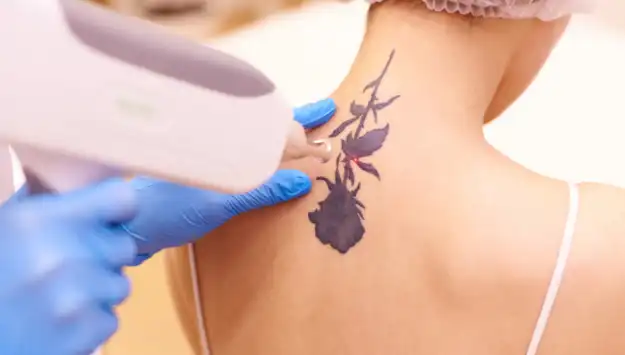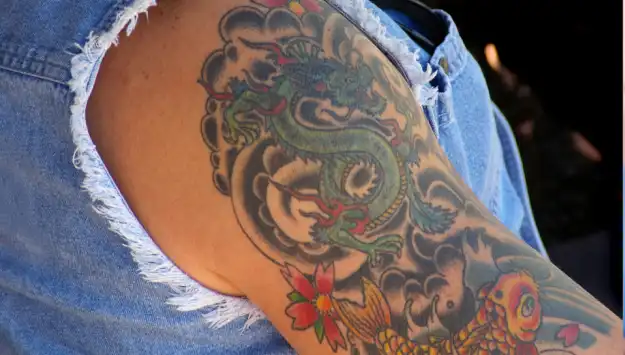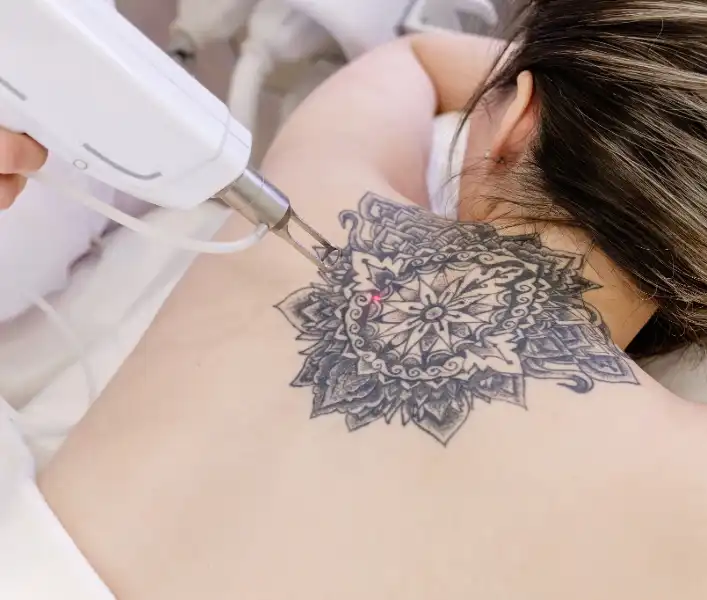In the field of dermatology, tattoos are categorized as artificial and cosmetic pigmentation of the skin. Tattoos are no longer believed to be permanent and irrevocable skin patterns or marks. Laser tattoo removal is a breakthrough procedure that helps to remove and fade undesirable tattoos with minimal side effects and optimal results. It is a safe and effective way to get rid of unwanted tattoos. Advanced technologies and painless procedures offer various procedures and techniques for tattoo removal. Skinisma offers the Best Skin Doctor and Best options for Tattoo Removal in Delhi. The success of the tattoo removal process depends on the dermatologist conducting the process. Hence it is recommended to opt Best dermatologist for Tattoo Removal.
Laser Tattoo Removal
This medical process involves removing tattoos with a laser that breaks up the pigment colors in our skin with a high-intensity beam. Because tattoo ink is present beneath the surface of the skin, it requires a surgical operation to remove it, which is more costly than having a tattoo in the first place.
Q-switch lasers are used in this technique, which emits intense pulse energy that breaks down the ink pigmentation in your skin and leads to tattoo removal.
Tattoos are divided into two categories:

Black and Grey Tattoo
Black and grey tattoos are usually toned down a bit and require shading and mixing of black and white ink. Our cutting-edge Q-switched lasers shatter pigment particles deep into the skin, allowing your immune system to scavenge and eliminate the pigment. As the tattoo fades in layers, at least 2-to 4 sessions are required to achieve the best effects. Since black pigment absorbs all laser wavelengths, it is the easiest tattoo to remove. They can be removed in as little as 2-3 sessions. It depends on the size and age of your tattoo.

Coloured Tattoo
Since these tattoos are deeply embedded in the skin, they are more difficult to remove. Such tattoos can take up to 5-6 sittings to erase. The color of your skin and the depth of tattoo ink penetration into your skin, Other colors, depending on their pigmentation, are some of the deciding factors which can affect how effective laser surgery is at removing tattoos.
As tattoos are meant to be a permanent mark on your skin, removing them can be a complex process. It is never guaranteed that your skin will return to its original state without scarring. Other options include surgery, dermabrasion, and other procedures.
Laser tattoo removal is one of the safest and least risky treatments available. It is the most recommended tattoo removal procedure because it is quick, painless, and most effective in removing larger, stronger, and complicated tattoos. The laser tattoo removal system breaks apart the pigment colors in the ink with a targeted-intensity light beam (high-intensity for complex colors) that dissolves the tattoo without leaving scars.
Laser procedure:
The wavelengths travel through the skin, breaking up the tattoo ink beneath it and allowing it to disintegrate and get absorbed. The ink is then broken up using a variety of wavelengths, with dark colors being the easiest to remove. Intense pulsed light therapy, or Diode, is similar to laser therapy in that it employs high-intensity light instead of laser light, but it is less unpleasant and more successful. Another improved procedure is surgical excision, which allows the surgeon to remove inked areas with greater precision. The tattoo is removed with a scalpel and the wound is stitched closed in this way. Skin laser treatment in Delhi is provided by the Best dermatologist for Tattoo Removal in Delhi who are experts with extensive experience in this field.
The different techniques for the removal of tattoos are:

Dermabrasion:
This is one of the tattoo removal treatments that use abrasion to remove the top few layers of skin and fade the original tattoo. It is an aggressive treatment as the skin will be open following abrasion, it may result in bleeding, scars, pain, and infection.
Excision:
This is a surgical method of tattoo removal in which the tattooed region is ‘dug in’ (cut) to remove the ink beneath the epidermal layer while the remaining area is stitched closed. The excision process takes around an hour to complete and requires two to three sessions to completely remove huge tattoos. Small tattoos can be removed in a single session.


Grafting of skin:
Skin grafting is a method of tattoo removal that is faster and less painful. This procedure is good for tattoos that are huge and ancient. Grafting tattoo removal entails more anesthesia, with the inked skin being totally removed as a graft and a new layer of skin being grafted in. It may leave a scar on the location where the skin is grafted if it is not done well cosmetically.
Although laser tattoo removal is considered safe, it is not a guarantee that your undesirable tattoo will be removed. The natural pigmentation of your skin may be changed after the treatment, or the process may create skin allergies if not done by an expert.
If you’re looking for a top-notch Tattoo Removal clinic in Janakpuri, New Delhi, look no further than Skinisma Aesthetics. Dr. Sweety Darall Tomar, Certified Dermatologist and cofounder, has over 15 years of experience and is dedicated to providing the best possible results for all our clients.
Contact us at +91-98-991-21263.


